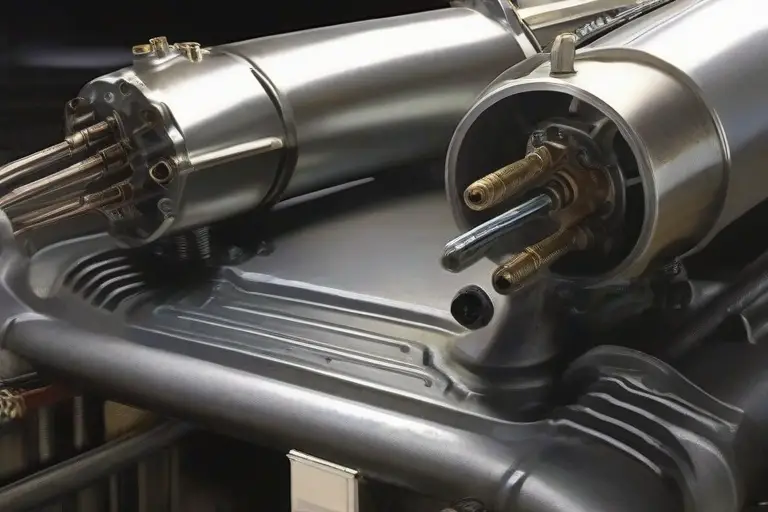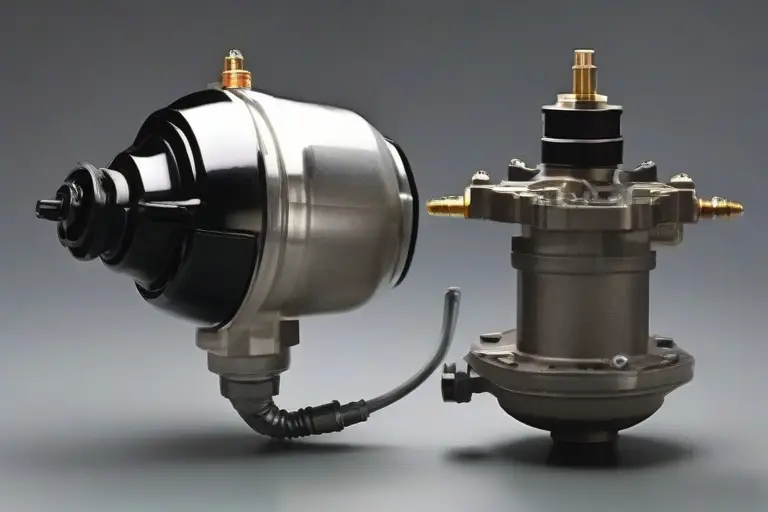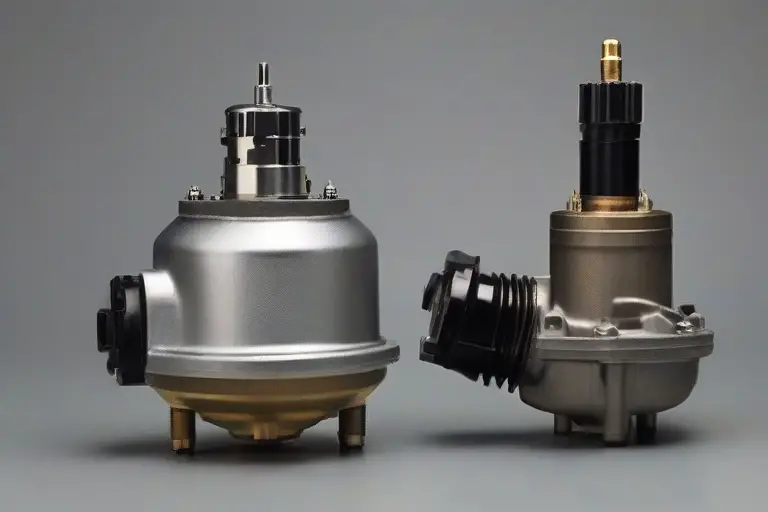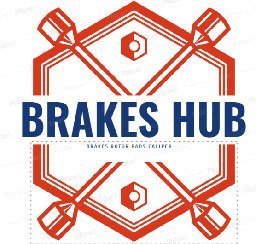Vacuum VS Hydro Boost Brake Boosters: Which One Better?
When it comes to breaking, there’s no room for compromise. Brake boosters play a crucial role in enhancing your vehicle’s braking efficiency, reducing stopping distances, and improving overall driver safety. These unsung heroes amplify the force you apply to the brake pedal, making it easier to bring your vehicle to a halt. Vacuum brake boosters rely on the engine’s vacuum to assist in braking, while hydro boost brake boosters use hydraulic pressure from the power steering pump.
Both types have their advantages and disadvantages, with vacuum boosters having a simpler design and hydro boosters offering better performance under heavier loads. Ultimately, the choice between the two will depend on factors like the weight of the vehicle and the driver’s personal preferences. It is important to consult a trusted mechanic before making a decision.
Have you ever wondered how your vehicle comes to a smooth stop, even at high speeds? Brake boosters hold the key to this remarkable feat, amplifying the force applied to the brake pedal and ensuring your safety on the road. Join us on a journey as we dive into the world of brake boosters, uncovering their secrets and exploring their impact on braking performance and driver confidence.
Table of Contents
What Is Hydro Boost?
Hydro boost is an innovative technology that has revolutionized the braking systems of 4×4 trucks. It relies on power steering pump pressure instead of engine vacuum to pressurize the brake system, drastically improving vehicle braking performance. This improved level of consistent pedal response is because the power steering pump is always pressurized, eliminating the need for manual pumping for stiffer brakes.
The most evident benefit of hydro boost is the unparalleled level of confidence it instills in drivers when negotiating steep downhill grades while off-throttle with cammed-up engines, which can struggle to deliver reliable vacuum at lower RPMs.
In addition, a ‘firmer’ pedal feel and more dynamic stopping capability are also notable hallmarks associated with hydro-boost installation. Upgrading your 4×4 vehicle with hydro-boost technology can improve your overall driving experience without compromising safety or reliability.
What is a Vacuum Brake?
The vacuum brake booster is crucial to an automobile’s braking system. It connects to the engine’s intake manifold to receive power. When the driver hits the brake pedal, the booster creates a vacuum that pressures the hydraulic brake lines. This pressure leads to greater friction, and the car stops.
Vacuum brakes can also fail due to insufficient vacuum pressure from the engine or if a leak in one of the internal bladders supplies the force to the hydraulic lines. For a vehicle’s brakes to remain reliable and properly functioning, regular maintenance must be done, including checking for any leaks in those parts that make up part of this system. By doing so, serious issues with your braking system can be avoided.

How Can I Test the Vacuum and Hydro Boost Brake?
Putting on a new brake isn’t enough. You need to test it to know if it’s working fine or not. You can run the below tests to see if the brakes are working fine or not.
Test for Vacuum Brakes
Supply Test
Carrying out a vacuum supply test on a vehicle’s booster is important in ensuring its optimal performance. Before starting the engine, it’s essential to pump the brake pedal to deplete the booster reserve. The next step involves disconnecting the vacuum supply hose from the booster and connecting a vacuum gauge with a cone-shaped adapter.
Allowing the engine to idle while reading the gauge makes it easier to measure accurately. On most vehicles, between 15” and 20” Hg (50 and 70 kph) should be displayed idle.
However, if this reading is low, you should check that there are no blockages in the vacuum hose or other mechanical faults, such as leaky valves or worn rings. An intake manifold vacuum leak or improper cam timing could also be possible causes for this reduction in source vacuum.
Valve Test
Testing the vacuum inlet check valve is essential to ensure its proper operation. The check valve functions as a one-way street, allowing only the vacuum to pass into the booster, which is necessary for proper brake performance. To test it, firstly, take the vacuum supply hose from the intake manifold or vacuum pump and blow it into the hose. If air passes through the valve and into the booster, the check valve might malfunction and should be replaced.
Inspecting and replacing any defective parts when needed is important to keep your car running smoothly. Replacing a faulty check valve can ensure that the optimal performance of your brake system will return.
When testing this part, it’s important to consider potential risks from working around utilities such as fuel lines or electric current. Additional steps may also be necessary depending on your car’s model, so consult with a certified professional if you are uncertain how to proceed with inspecting and servicing your vehicle.
Test for Hydro boost Brake
Power Assist Test
The hydro-boost power assist system uses hydraulic pressure instead of a vacuum to provide assistance with braking. This means greater assistance than a vacuum system is available, resulting in higher performance and control.
The hydro boost has an accumulator that helps provide several power-assisted stops if the system experiences a disruption such as a belt breakage or hose rupture.
To ensure that the hydro-boost power assist system is functioning properly, it is important to inspect key components such as hoses, pumps, and drive belts for leaks, any lower power steering fluid levels, and test operation and accumulator performance.
Control over fluids running in or out of the hydro-boost is handled by spool valves, cylinders filled with machined rings inside them. These spool valves can also be found in other hydraulic components, such as valve bodies included in automatic transmissions.
Function Test
Performing the hydro-boost function test is an important step in ensuring the safety of your vehicle. The test checks to see if the hydro-boost system, which multiplies available braking power when activated, works properly.
To begin the test, switch off the engine and apply medium force on the brake pedal five or more times, which will discharge any power stored in the accumulator. Afterward, you should notice a hardening of the brake pedal.
Next, start up your engine and repeat this process with medium force – if everything is functioning as it should be, then you’ll find that the brake pedal moves downward slightly toward the floor before pushing back upward.
However, if there’s no change in its position or feel, something’s not working correctly, and you must investigate further. If all goes well during this process and it passes this basic test, proceed to do an accumulator test.

Pros & Cons of Vacuum vs Hydro Boost Brake Boosters
Vacuum Brake Boosters
| Pros | Cons |
|---|---|
| Simple and reliable design | Limited boost power |
| Low maintenance | Reduced performance at high altitudes |
| Low cost | Vacuum leaks can cause loss of brake boost |
Hydro boost Brake Boosters
| Pros | Cons |
|---|---|
| More powerful than vacuum boosters | More complex design |
| Consistent performance regardless of altitude | Higher maintenance |
| No vacuum leaks | More expensive |
Important Facts
According to a study conducted by the National Highway Traffic Safety Administration, vehicles equipped with hydro-boost brake boosters are involved in fewer accidents than those with vacuum boosters. The study found that the accident rate for vehicles with hydro-boost brake boosters was 35% lower than those with vacuum boosters.
Comparison Between the Two Systems
Brakes are one of the most essential safety features in any vehicle. The two most commonly used brake booster systems are the vacuum and hydro-boost. Both systems serve the same purpose, which is to amplify the force exerted on the brake pedal by the driver. However, there are a few key differences between the two systems. In this article, we will compare the vacuum and hydro-boost brake boosters to see which one comes out on top. We will examine both systems’ mechanisms, benefits, and drawbacks to give you a comprehensive analysis of which brake booster is better for your vehicle.
1. Performance
Hydro boost brake boosters are generally considered to provide better performance compared to vacuum boost brake boosters. This is because hydro boost systems use power steering fluid pressure to assist with the brakes, resulting in a more immediate and reliable response. Vacuum boost systems, on the other hand, rely on vacuum pressure generated by the engine, which may lead to slower response times.
2. Maintenance & Repairs
When it comes to maintenance and repairs, vacuum boost brake boosters are generally easier and less costly to maintain and repair. They have fewer components and are simpler in design, making them easier to diagnose and fix. Hydro boost systems, on the other hand, are more complex and require specific tools and knowledge to repair, leading to higher repair costs.
3. Cost Effectiveness & Durability
Vacuum boost brake boosters are generally considered more cost-effective and durable in the long run. They have a long track record of performance and reliability, and replacement parts are widely available and affordable. Hydro boost systems, on the other hand, can be more expensive to install and maintain, and replacement parts may be harder to find. However, hydro-boost systems are generally more durable and last longer than vacuum-boost systems, making them a better investment in the long run.
Overall, the choice between vacuum vs hydro boost brake boosters ultimately depends on your specific needs and preferences. While hydro boost systems may provide better performance, they come at a higher cost and may be more difficult to maintain and repair. Vacuum boost systems, on the other hand, are more cost-effective and easier to maintain, but may not provide the same level of performance. Ultimately, it’s up to you to decide which system best fits your needs.

Factors to Consider When Choosing a Brake Booster System
When it comes to the safety of your vehicle, the role played by the braking system can never be overemphasized. The brake booster system is one of the essential components of the braking system in a car. It is a crucial component that enhances the brake pedal’s performance. Choosing the appropriate brake booster system for your car is vital. There are various types of brake booster systems, such as vacuum and hydro-boost systems, among others. Several factors come into play when selecting a brake booster system for your car. In this article, we shall discuss some of the factors you should consider when choosing a brake booster system for your vehicle.
1. Vehicle Size & Weight Capacity
The size and weight of your vehicle are important factors to take into consideration when selecting a brake booster system. Larger vehicles and those carrying a heavier load will require a more powerful system to ensure that the brakes are functioning properly. It’s crucial to select a system that is capable of delivering the needed stopping power for your specific vehicle.
2. Power Output Requirements
Another factor to consider when choosing a brake booster system is the power output requirements. Different systems will have varying levels of power output, measured in terms of psi. It’s important to select a system that is capable of delivering the necessary power output to effectively stop your vehicle. Factors such as tire size, the number of wheels on the vehicle, and the weight distribution of the vehicle can all affect the needed power output of the brake booster system.
Which One Should I Choose?
When choosing between a vacuum brake booster or a hydro-boost system, there are several factors to consider. Both brake boosters use power assist to make braking easier but they have different advantages and drawbacks.
Vacuum boosters are the more common choice for cars and light trucks. They use engine vacuum from the intake manifold to help apply force on the master cylinder piston, increasing brake pedal pressure. Vacuum boosters are relatively inexpensive and easy to install. However, they do not provide as much power assistance as a hydro-boost system.
On the other hand, hydro-boost systems offer more power assist than vacuum boosters, making them ideal for heavier vehicles such as SUVs and trucks. They use hydraulic pressure from the power steering pump to amplify the braking power. Hydro boost systems are more expensive and difficult to install, but they can provide smoother braking with less brake pedal effort.
Ultimately, the type of system you choose should depend on your vehicle’s size, weight, and performance needs. If you’re unsure which one is right for you, it’s best to consult a certified professional for advice.
Frequently Asked Questions [FAQs]
1. Can I upgrade from a vacuum brake booster to a hydro boost brake booster?
In most cases, it is possible to upgrade from a vacuum brake booster to a hydro boost brake booster. However, it is important to note that this is not a simple plug-and-play swap. The installation process can be more involved and may require modifications to the braking system and power steering system.
2. How Often Should I Check My Hydro-Boost System?
You should check your hydro-boost system regularly, as any issues can increase the risk of an accident or injury. You should also inspect the key components such as hoses, pumps, and drive belts for leaks, low power steering fluid levels, and test operation and accumulator performance. If you notice any problems, have the system inspected and repaired immediately.
3. What Is The Difference Between A Brake Booster And A Vacuum Pump?
A brake booster and a vacuum pump are two different components that work together to provide a hydraulic braking system for a vehicle. The brake booster is a device that increases the line pressure in the hydraulic braking system by using pressure from the engine vacuum or an externally applied pressure source, such as a hydro-boost system. A vacuum pump is a device that draws air out of the atmosphere and creates a vacuum to move air through the brake booster and activate the system.
4. What Is The Advantage Of Hydro Boost Brakes?
The main advantage of hydro boost brakes is the increased braking power. The hydro-boost system uses hydraulic pressure from the power steering pump to increase brake force and reduce pedal effort. This allows for more effective stopping power without increasing pedal effort, which can be beneficial when a driver needs to make a quick stop or when more braking force is required when carrying heavier loads. Additionally, the hydro-boost system is more resistant to wear and tear than a vacuum booster.
5. Will A Brake Booster Work Without A Vacuum?
No, a brake booster will not work without a vacuum. A brake booster is an air-assisted device that uses either a vacuum or a hydro-boost system to increase the force the driver’s foot applies on the brake pedal. Vacuum-assisted boosters use engine vacuum to create suction in the booster, amplifying the pressure applied to the brakes.
Conclusion
The debate between vacuum and hydro boost brake boosters has been ongoing for years. Both options have their advantages and disadvantages, making it difficult to determine which one is truly better. Vacuum brake boosters are more commonly used and have been around for a longer time. They are generally more affordable and easier to install, making them a popular choice among car enthusiasts. However, vacuum brake boosters can be less effective in certain situations, such as when the engine is under high load or when the vacuum pump fails.
Ultimately, the choice between vacuum and hydro-boost brake boosters depends on your specific needs and preferences. If you value affordability and simplicity, vacuum brake boosters may be the better option for you. However, if you prioritize performance and reliability, hydro-boost brake boosters may be worth the extra cost and effort.
